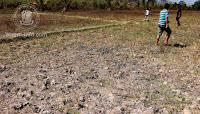ARMM gov’t assists farmers affected by El Niño in Maguindanao
Cotabato City (March 01, 2016) – The Autonomous Region in Muslim Mindanao (ARMM) will increase its support to farmers affected by drought in Maguindanao. As of date, dry spell and rat infestation in the province destroyed more than P110-million worth of agricultural crops.
Reports from the ARMM’s Agriculture and Fisheries department (DAF-ARMM) showed that 18,831 hectares of rice and corn farms in 18 municipalities in Maguindanao, with roughly 22,000 farmers, have been affected by the adverse weather condition now felt not only in ARMM but also in many parts of the country.
In late January, the province has been placed under a state of calamity due to rising drought damage figures. Alexander Alonto, DAF-ARMM Secretary, said his office is expecting higher loss figures in the near term as municipal officers further validate updated reports on the extent of crop damage.
The region’s Agriculture department has already provided 4,400 bags of open-pollinated corn seeds and 3,000 bags of palay to affected farmers. “It is part of the region’s intervention to farmers affected by the drought,” Sec. Alonto said. He reiterated that DAF-ARMM is still waiting for updates from municipalities hit hard by the dry spell.
Identified towns significantly affected by both drought and rat attacks in Maguindanao are: Datu Abdullah Sangki, Datu Anggal Midtimbang, Datu Montawal, Datu Unsay, Guindulungan, Kabuntalan, North Upi, South Upi, Sultan Kudarat, Sultan Mastura, Talayan, Ampatuan, and Datu Piang.
Emma Ali, provincial social welfare officer, said the local office of the Department of Social Welfare and Development has distributed relief packs to affected residents noting her office is still validating latest reports.
“We will immediately respond to their humanitarian needs as long as we get the complete data assessed by the municipal officers,” Ali said. Based on a report from the Philippine Atmospheric, Geophysical, and Astronomical Services Administration, the dry spell, referred to as ‘El Niño’, is expected to be felt until the second quarter of this year.
El Niño is an abnormal warming of surface water in the eastern tropical sections of the Pacific Ocean generally observed once in three to five years. The phenomenon, the weather agency said, usually occurs during the last quarter of the year and lasts until the first half of the following year. (Bureau of Public Information)
Reports from the ARMM’s Agriculture and Fisheries department (DAF-ARMM) showed that 18,831 hectares of rice and corn farms in 18 municipalities in Maguindanao, with roughly 22,000 farmers, have been affected by the adverse weather condition now felt not only in ARMM but also in many parts of the country.
In late January, the province has been placed under a state of calamity due to rising drought damage figures. Alexander Alonto, DAF-ARMM Secretary, said his office is expecting higher loss figures in the near term as municipal officers further validate updated reports on the extent of crop damage.
The region’s Agriculture department has already provided 4,400 bags of open-pollinated corn seeds and 3,000 bags of palay to affected farmers. “It is part of the region’s intervention to farmers affected by the drought,” Sec. Alonto said. He reiterated that DAF-ARMM is still waiting for updates from municipalities hit hard by the dry spell.
Identified towns significantly affected by both drought and rat attacks in Maguindanao are: Datu Abdullah Sangki, Datu Anggal Midtimbang, Datu Montawal, Datu Unsay, Guindulungan, Kabuntalan, North Upi, South Upi, Sultan Kudarat, Sultan Mastura, Talayan, Ampatuan, and Datu Piang.
Emma Ali, provincial social welfare officer, said the local office of the Department of Social Welfare and Development has distributed relief packs to affected residents noting her office is still validating latest reports.
“We will immediately respond to their humanitarian needs as long as we get the complete data assessed by the municipal officers,” Ali said. Based on a report from the Philippine Atmospheric, Geophysical, and Astronomical Services Administration, the dry spell, referred to as ‘El Niño’, is expected to be felt until the second quarter of this year.
El Niño is an abnormal warming of surface water in the eastern tropical sections of the Pacific Ocean generally observed once in three to five years. The phenomenon, the weather agency said, usually occurs during the last quarter of the year and lasts until the first half of the following year. (Bureau of Public Information)




